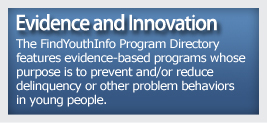Basic Needs, Safety, and Welfare
For some youth, the transition to adulthood presents a number of challenges in meeting their basic needs. They may not be able to find employment that offers health benefits, no longer be included in their parents' insurance, or have become too old to qualify for Medicaid or SCHIP. Finding safe, affordable housing can be a challenge. For youth leaving foster care or juvenile detention facilities, youth who have run away from home or dropped out of school, or youth with disabilities, the challenges can be even greater.
Health, Mental Health, Pregnancy, and Childbearing
- Dropouts have a life expectancy nine years less than the average high-school graduate (Levin, 2005).
- Former foster youth report they find it difficult to secure health coverage in their first years on their own (National Conference of State Legislatures).
- CBO estimates that 60% of former foster youth qualify for some type of publicly funded health program (Medicaid, SCHIP, or another option) (English & Grasso, 2000).
- Between 50 and 75% of incarcerated youth are estimated to have a diagnosable mental health disorder (National League of Cities, 2005).
- Roughly 10 to 12% of all youth will experience a mental health problem significant enough to require short-term special services and treatment at some point in their teenage years (Podmostko, 2007).
- Eighty percent of youth in foster care have received services for mental health issues during placement (U.S. Department of Health and Human Services, Administration for Children and Families, n.d).
- Forty-five percent of homeless youth reported mental health problems in the last year (Burt, 2007).
- Suicide is the third leading cause of death among 15 to 24 year olds (U.S. Department of Human Services, Centers for Disease Control and Prevention, 2011).
- Four years after leaving foster care, 42% of youth have become parents (National League of Cities, 2005).
- Eighteen percent of today's 15-year-old girls will give birth before age 20. One in every three teen mothers is a dropout (National League of Cities, 2005).
- About 50% of street youth have had a pregnancy experience compared to about 33% of youth living in shelters (Greene & Ringwalt, 1998).
Housing
- Each year, 24,000 young people age out of foster care and are expected to transition to independent living (Gardner, 2008).
- Approximately one in five youth who age out of foster care will experience homelessness (Fernandes, 2008).
- Three in ten homeless adults have had experience in the foster care system (Gardner, 2008).
Burt, M. R. (2007). Understanding homeless youth: Numbers, characteristics, multisystem involvement, and intervention options. Testimony before the U.S. House Committee on Ways and Means, Subcommittee on Income Security and Family Support. Retrieved from http://www.urban.org/UploadedPDF/901087_Burt_Homeless.pdf (PDF, 14 pages)
English, A., & Grasso, K. (2000). The Foster Care Independence Act of 1999: Enhancing youth access to health care. Journal of Poverty Law and Policy, 34, 217-232. Retrieved from http://www.americanbar.org/content/dam/aba/migrated/child/PublicDocuments/englishgrasso.authcheckdam.pdf (PDF, 16 pages)
Fernandes, A. L. (2008). Youth transitioning from foster care: Background, federal programs, and issues for Congress. Prepared for Members and Committees of Congress. Retrieved from http://www.fosteringconnections.org/tools/assets/files/CRS-older-youth-report.pdf (PDF, 82 pages)
Gardner, D. (2008). Youth aging out of foster care: Identifying strategies and best practices. Washington, DC: National Association of Counties.
Greene, J.M., & Ringwalt, C.L. (1998). Pregnancy among three national samples of runaway and homeless youth. The Journal of Adolescent Health, 23(6), 370-377.
Levin, H. M. (2005). The Social Costs of Inadequate Education. New York: Teachers College, Columbia University. Retrieved from http://www.tc.columbia.edu/i/a/3082_socialcostsofinadequateEducation.pdf (PDF, 24 pages)
National Conference of State Legislatures. Retrieved from http://www.ncsl.org/
National League of Cities. (2005). Reengaging disconnected youth: Action kit for municipal leaders. Retrieved from Retrieved from http://www.nlc.org/File%20Library/Find%20City%20Solutions/IYEF/At-Risk%20Youth/disconnected-youth-action-kit-apr07.pdf (PDF, 14 pages)
Podmostko, M. (2007). Tunnels and cliffs: A guide for workforce development practitioners and policymakers serving youth with mental health needs. Washington, DC: National Collaborative on Workforce and Disability for Youth, Institute for Educational Leadership. Retrieved from http://www.ncwd-youth.info/tunnels-and-cliffs
U.S. Department of Health and Human Services, Administration for Children and Families. Adoption and Foster Care Analysis and Reporting System (AFCAR). Retrieved from http://www.acf.hhs.gov/programs/cb/systems/
U.S. Department of Health and Human Services, Centers for Disease Control and Prevention (2011). Preventing Suicide: Program Activities Guide. Retrieved from http://www.cdc.gov/violenceprevention/pdf/PreventingSuicide-a.pdf (PDF, 8 pages)
Resources
U.S. Department of Health and Human Services
Administration for Children and Families/Family and Youth Services Bureau
Runaway and Homeless Youth Programs
Eligibility: Youth aged 16 to 22 who are unable to return to their homes
Focus: Life skills training
Runaway and Homeless Youth Programs that serve transition-age youth include the Transitional Living Program and the Maternity Group Homes Program.
The Transitional Living Program for Older Homeless Youth promotes the independence of youth between 16 and 22 years old who are unable to return to their homes. Grantees provide housing and a range of services, including life skills training, financial literacy instruction, and education and employment services. Youth might live in group homes or in their own apartments, depending on the program and each young person's independent living skills.
The Maternity Group Homes Program, part of the Transitional Living Program, supports homeless pregnant and/or parenting young people between the ages of 16 and 22, as well as their dependent children. Services are provided for up to 21 months.
U.S. Department of Housing and Urban Development (HUD)
Family Unification Program
Eligibility: Youth aged 18-21 who have aged out of foster care
Focus: Housing
The Family Unification Program provides Housing Choice Vouchers to communities to help assist in the transition of youth out of foster care. The Public Housing Authority administers the vouchers and the child welfare agency provides supportive services to youth. Vouchers are used to provide rental assistance to youth aged 18 to 21 who transition from foster care or who leave foster care at age 16 or older. The voucher subsidizes the rent of eligible youth for up to eighteen months.
Youth Topics
Collaboration Profiles
Briefs
Youth Voices
Feature Articles
Tools & Guides
Programs
Technical Assistance
Websites
Publications
Videos & Podcasts
Data Sources


Announcements
Youth Topics
Collaboration Profiles
Briefs

Map My Community is a tool designed specifically to assist you in locating resources in your community to help you build and strengthen your youth program. Get ideas for new partnerships, identify gaps in your community, and learn about resources to avoid duplication of effort.



















